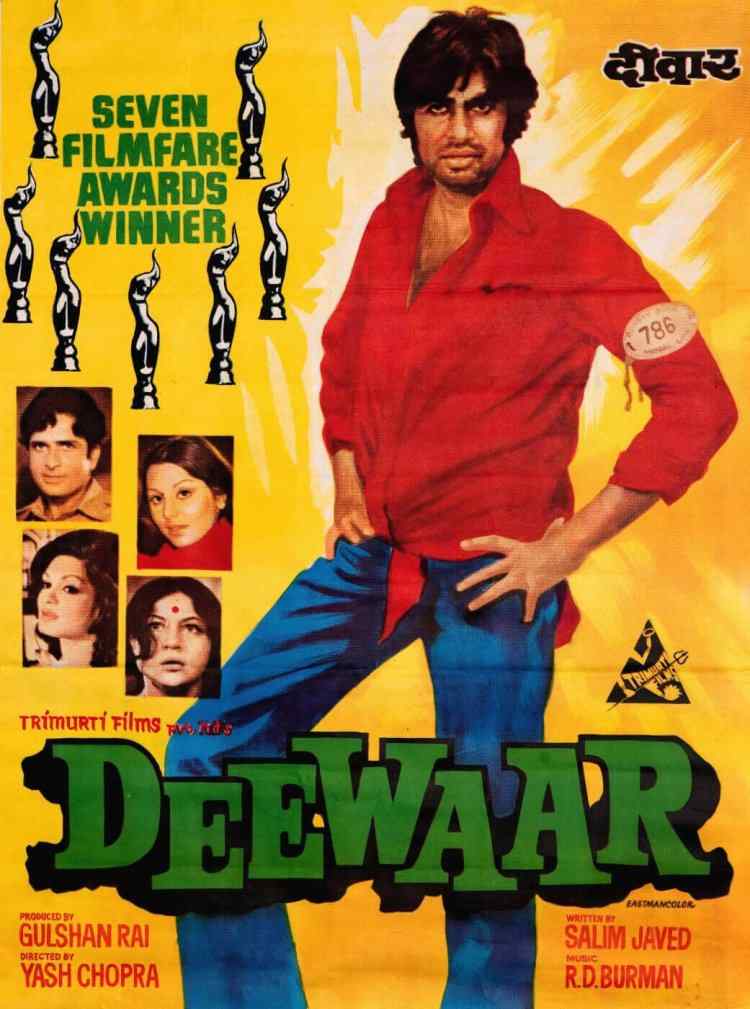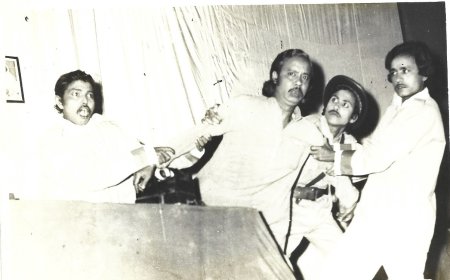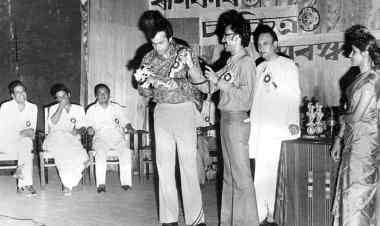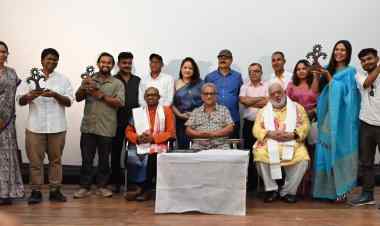DEEWAR AND VIJAY’S BADGE NUMBER 786

Shoma A. Chatterji, a distinguished Indian film scholar and accomplished author, delves into the intricacies of the cinematic masterpiece "Deewar" and its profound symbolism surrounding Vijay's badge number 786.
Deewar celebrates its 48th birthday this year. Indiatimes ranks Deewaar amongst the Top 25 Must See Bollywood Films. It was one of the three Hindi films featured in the book 1001 Movies You Must See Before You Die, the others being Mother India (1957) and Dilwale Dulhania Le Jayenge (1995). The film was released the same year as Sholay was, famous as the “greatest story ever told” yet, several decades later, Deewar remains as enigmatic, charismatic and mesmerizing as Sholay is till this date.
In Yash Chopra’s Deewar, Vijay drops out of school because he has to begin working and finance his younger brother Ravi’s education. He is bold, forthright and rough. He lands a job as a porter in a shipping dock in Bombay. He is given a brass identification badge by a senior Muslim comrade. The badge has the number 786 engraved on it and this comrade tells him that the brass identification badge is lucky because the number 786 is the numerological equivalent of the Arabic letters that spell bismillah which means ‘in the Name of God’. This badge denotes hard labour and identification with Muslim subalterns. This later became a recurring feature of Bachchan’s angry-young-man screen persona, evolves into the sole talisman, the good luck charm in the young, angry and gutsy Vijay’s sad and lonely life and actually protects him from danger.[1]
Vijay believes in his senior colleague Rahim Chacha, a Muslim by the way, and wears the badge at all times. Over the script, we discover that the badge saves him by shielding the shot that targets him. Vijay’s faith in the ‘luck’ element in the badge increases over time so much that he thinks that separating himself from that badge might be a life-threatening tragedy. But it dropped out and fell across the pavement. At this point perhaps, the badge could be construed as having becoming a fetish for Vijay.
The climax in Deewar shows the badge falling off with its sounds as it rolls on the street. He is trying to escape from the clutches of the law when Ravi, his brother, the police officer chases him. The badge falls with a resounding clatter on the other side of iron fencing. Vijay stretches his hand to reach and reclaim it but it is beyond his reach. He dies and the film tries to establish that his estrangement from the badge could be an important factor that led to his tragic and untimely death. But is this really so? Or, did he really write his own death warrant without being aware of it?
Ranjani Mazumdar[2] gives a lucid analysis of the badge stating how “the number on Vijay’s dockworker identification badge – operates as a symbolic object that involuntarily negotiates memory through chance encounters.” She adds that it assumes the status of a fetish object perhaps in one of the many meanings attached to the word ‘fetish’ which states, that in one sense, the word refers to “the attribution of religious or mystical qualities to inanimate objects, known as fetishes.”[3]. She goes on to add: “The badge becomes the object of memory, evoking a multilayered realm of meaning. The status of the badge changes when Vijay changes his proletarian clothing to become a smuggler – no longer worn on his arm, the badge rests uneasily in his pocket. Its magical powers are exaggerated by its very ability to transcend its initial functionality in Vijay’s coolie (dockworker) stage……the badge maintains an uneasy relationship to the body, allowing Vijay to move between different social spaces – notably his transition to a higher lifestyle. The displacement of the badge from the arm to the pocket evokes a desire for class ascendancy, while it draws attention to its “origins.” She elaborates how the badge along with the tattoo on his forearm “mera baap chor hai” (My father is a thief) heighten Vikay’s identity, marking him as different from his brother. While Vijay is not able to transcend his fate, Ravi manages to do so.
Some years later, for Coolie, Amitabh Bachchan wore a badge with the same Billa Number 786. This time, claims Bachchan on a social networking site, the badge saved him in real life during a shoot for the film.[i] After Deewar became a box office hit, number plates of cars carried the number 786 and ladies created a demand for necklaces and pendants bearing the Number 786. The badge therefore, has use-value for Vijay as his identification number. It has exchange-value because though it is a gift, it was bought at some time by some one. It has symbolic value because for Vijay, it holds more emotional value by virtue of being a gift from a senior who has a strong liking for him. It has sign value because it stands out like a lucky talisman his other possessions do not hold for him.
Among the audience, the badge acquired a status value and an identification value for those who chased pendants, chains and car licence plates carrying the Billa Number. It also acquired a kind of emotional and psychological value by virtue of the fact that Vijay’s belief in the number on lucky charm transferred itself to many among the mass audience, indicating the tremendous influence of cinema on its audience. The basic fact that Deewar is a film based on a piece of fiction, that everything in it was make-believe including Vijay and his talisman did not come in the way of the audience being swayed towards the number the badge carried.
It may be noted that the object – the brass badge that had an old and weathered look – was less important than the number it carried. No one ran after a similar badge or ordered one because the porter’s badge identified with a porter – belonging to a lower rung of the working class in Bombay. So, the audience chased the number not on badges but on cars, pendants and necklaces identified with the upper middle class and the higher class.
The badge, looked at in retrospect, also brings in a point of harmony between the majority and a minority community in India. The number on the badge carries a clear, Muslim connotation and association. But it unified the audience and did not bring into question the communal differences between Vijay and his colleague Rahim Chacha who pointed out to him the merits of the badge carrying the specific number.
From these varied perspectives, one discovers with a degree of enlightenment that these objects throw up readings that within the Indian context, when objects are culture-specific as they very often are in cinema, they refuse to remain trapped within theory.
***
[1] http://www.uiowa.edu/~incinema/Deewar.html
[2] The Arabic letters of the opening phrase of the Qur'an sum to the numerical value 786 in the system of Abjad numerals. Not all Muslims place emphasis on this numerological analysis; however, some — mostly in India, Pakistan, Bangladesh and Myanmar — use 786 as a substitute for the phrase بسم الله الرحمن الرحيم bism illāh ir-raḥmān ir-raḥīm ("in the name of Allah, the compassionate, the merciful") http://newdelhi.olx.in/
[3] Mazumdar, Ranjani: Bombay Cinema: An Archive of the City, Permanent Black, University of Minnesota, 2007 pp.25-26.
What's Your Reaction?


































































